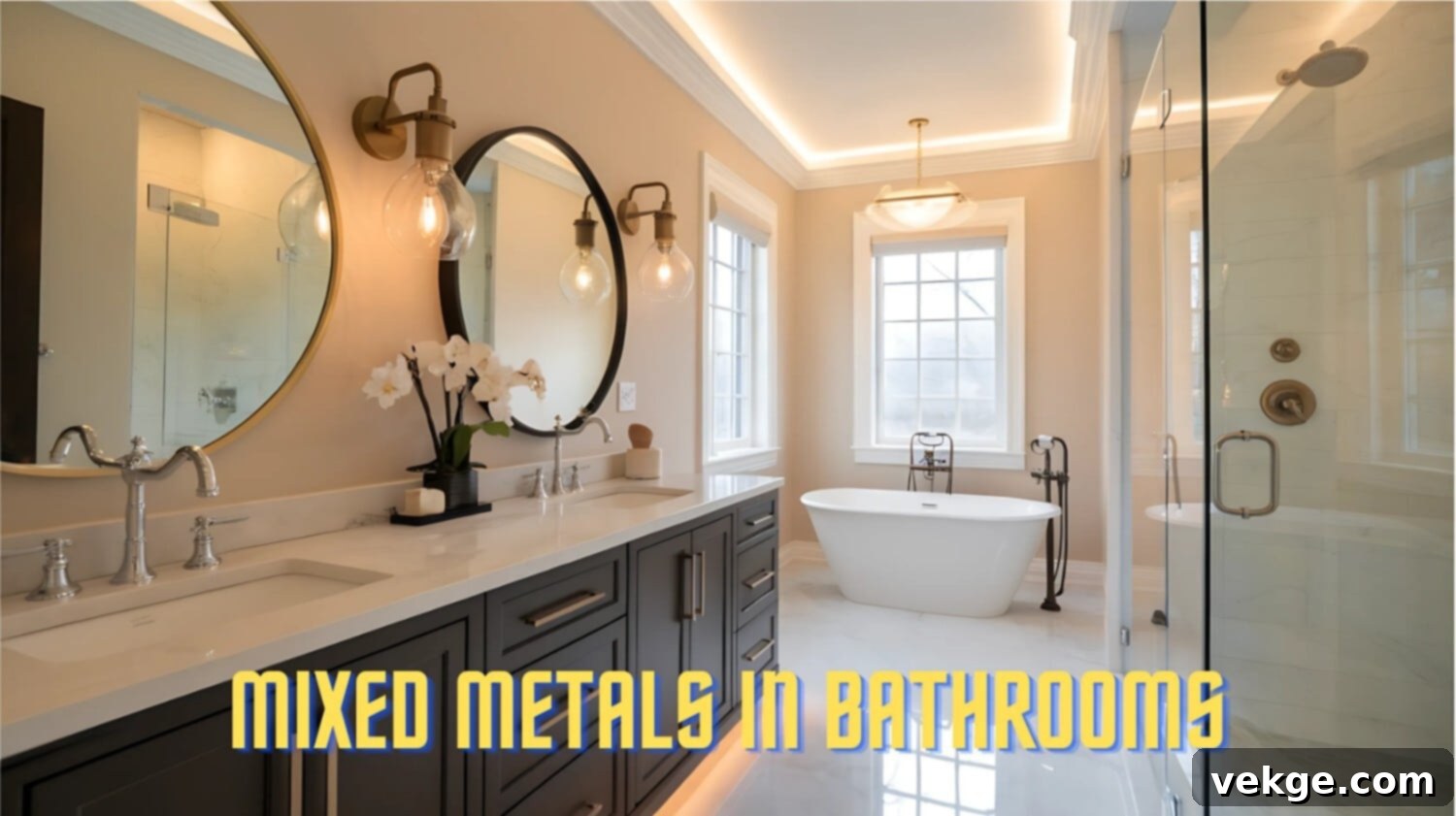Mastering the Art of Mixing Metals in Bathroom Design: A Comprehensive Guide
The era of perfectly matching every fixture in your bathroom is a thing of the past. Today’s interior design landscape celebrates individuality and curated aesthetics, with mixing metals emerging as one of the most exciting and sophisticated trends in bathroom design. This innovative approach allows you to transform an ordinary bathroom into a truly magnificent and personalized sanctuary.
By thoughtfully blending different metal finishes, you can inject depth, visual intrigue, and a sense of bespoke luxury into your space. This isn’t just about randomly pairing finishes; it’s an art that, when mastered, creates a thoughtfully curated environment that feels far from cookie-cutter. Whether you’re embarking on a full-scale bathroom renovation or simply looking to refresh its current aesthetic, understanding the principles of mixing metals can elevate your design to an unparalleled level of style and sophistication.
This comprehensive guide will demystify this captivating design trend, providing you with the knowledge and confidence to create a bathroom that is both on-trend and possesses timeless appeal. Discover the secrets to harmonizing diverse metallic elements and designing a space that truly reflects your unique taste.
Understanding Bathroom Metal Finishes: Your Essential Guide
Before diving into the art of mixing, it’s crucial to understand the characteristics of various popular metal finishes available for bathroom fixtures and hardware. Each finish offers a distinct personality and contributes differently to the overall ambiance of your bathroom.
1. Common Metal Finishes and Their Unique Personalities
The market for bathroom metal finishes has expanded dramatically, offering a rich palette to choose from. Each finish carries its own aesthetic and functional attributes:
- Chrome: A timeless classic, chrome is celebrated for its bright, highly reflective, and mirror-like sheen. Its cool, crisp appearance makes it incredibly versatile, effortlessly complementing a wide array of bathroom styles, from minimalist contemporary to traditional. Chrome is durable and relatively easy to clean, making it a perennial favorite for faucets, showerheads, and hardware.
- Brass: Making a significant comeback, brass introduces a warm, inviting, and luxurious golden touch. It comes in various forms, including polished, satin, or unlacquered, each offering a different degree of shine and aging potential. Polished brass exudes classic elegance, while a brushed or satin finish provides a softer, more subdued warmth. Unlacquered brass develops a beautiful patina over time, adding character and a vintage feel.
- Nickel: Offering a softer luster than chrome, nickel is available in both polished and brushed variations. Polished nickel provides a warm, silver-toned shine that feels more traditional and refined than chrome. Brushed nickel, on the other hand, presents a muted, matte appearance that is excellent at concealing water spots and fingerprints, making it a practical and popular choice for busy bathrooms, providing a subtle sophistication.
- Matte Black: A frontrunner in modern design trends, matte black delivers a bold, dramatic, and undeniably contemporary look. Its non-reflective surface creates a strong contrast against lighter materials and colors, lending an architectural feel to the space. Matte black is perfect for achieving an industrial, minimalist, or high-contrast design aesthetic.
- Oil-Rubbed Bronze: With its deep, rich, and often mottled dark brown appearance, oil-rubbed bronze is ideal for evoking a rustic, vintage, or old-world charm. This finish often features coppery undertones that become more prominent with use, adding to its antique character. It’s a fantastic choice for traditional, farmhouse, or Mediterranean-inspired bathrooms.
2. The Art of Balancing Warm vs. Cool Metals
One of the foundational principles in mixing metals is understanding the distinction between warm and cool tones. This distinction significantly impacts the mood and perceived temperature of your bathroom space.
- Warm Metals: Metals like brass, gold, and copper fall into this category. They emanate a golden or reddish glow, making a room feel inherently cozier, more inviting, and luxurious. Warm metals reflect light with a golden tint, creating an opulent, spa-like atmosphere perfect for master bathrooms or spaces designed for relaxation. Their presence can visually warm up a room with cooler color palettes.
- Cool Metals: Chrome, polished nickel, and stainless steel are examples of cool metals. These finishes offer a crisp, fresh, and often sparkling appearance that can make a space feel brighter, cleaner, and more expansive. They reflect light with a slight blue or silver tint, which can be particularly effective in smaller bathrooms where a sense of openness is desired. Cool metals pair beautifully with cool color schemes like blues and grays, enhancing their serene qualities.
Thoughtfully choosing between or combining warm and cool metals allows you to finely tune the emotional impact and perceived temperature of your bathroom. The key is to create a harmonious balance that complements your desired mood.
3. Polished vs. Brushed Finishes: Texture and Practicality
Beyond color, the texture of your metal finishes plays an equally important role in defining the aesthetic and practicality of your bathroom design. Finishes can be broadly categorized as polished or brushed:
- Polished Finishes: These finishes, such as polished chrome, polished brass, or polished nickel, are characterized by their high-gloss, mirror-like reflectivity. They capture and bounce light extensively, making a bathroom feel more glamorous and expansive. Polished metals are excellent for creating striking focal points, adding a touch of drama and formality. However, their highly reflective nature also means they are more prone to showing water spots, fingerprints, and smudges, requiring more frequent cleaning to maintain their pristine look.
- Brushed Finishes: In contrast, brushed finishes (e.g., brushed nickel, satin brass, matte black) have a softer, more muted, and less reflective appearance. These finishes are created by lightly abrading the metal, resulting in a subtle, textured look. Brushed metals are highly effective at concealing minor imperfections, water spots, and fingerprints, making them a more forgiving and practical choice for high-traffic areas. They add a sophisticated, understated texture and depth to your bathroom without overwhelming the senses, contributing to a more relaxed and contemporary feel.
Mixing polished and brushed finishes can add a dynamic layer of interest, preventing the room from feeling flat. For instance, a gleaming polished faucet might be beautifully complemented by a brushed cabinet pull, creating a subtle yet impactful contrast.
How to Seamlessly Mix Metal Finishes in Your Bathroom
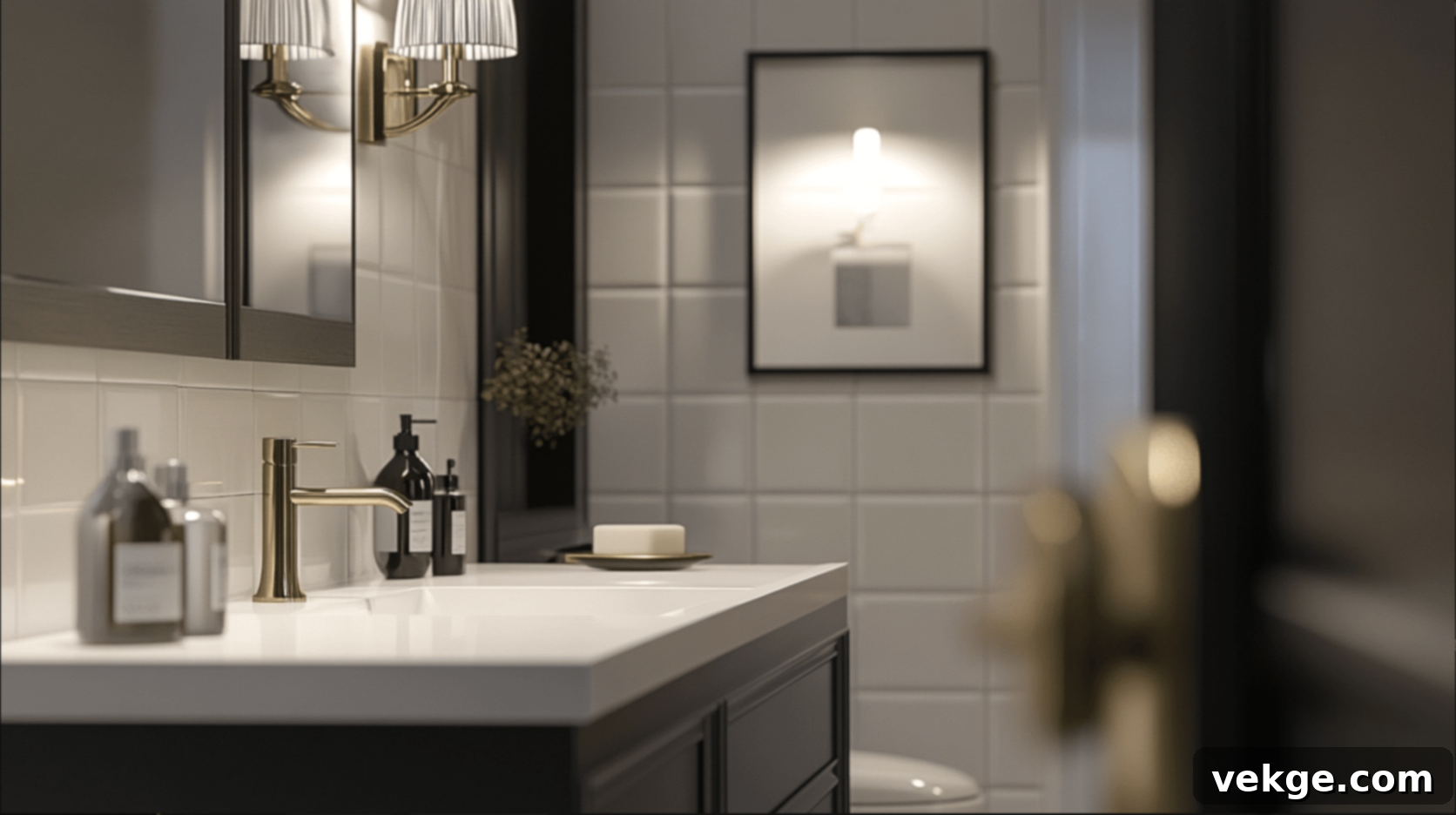
Successfully mixing metal finishes requires a strategic approach to ensure a cohesive and sophisticated result. Here’s a detailed guide to mastering this design technique:
- Establish a Dominant Metal: Your Design Anchor
Begin your mixing journey by selecting one primary metal finish that will serve as the anchor for your bathroom’s design. This dominant metal should be featured on your largest or most prominent fixtures, such as your main faucets, shower system, or light fixtures. Opt for a finish you genuinely love and that aligns with the overall aesthetic you envision. For instance, if you’re aiming for a modern spa feel, polished chrome or brushed nickel might be your dominant choice. - Introduce a Secondary Metal for Thoughtful Contrast
Once your dominant metal is chosen, select a second metal that offers a pleasing contrast. The most effective way to do this is by contrasting warm with cool tones. If your primary metal is cool (e.g., chrome or brushed nickel), introduce a warm metal (e.g., brass or gold) for your secondary elements. Conversely, if your primary metal is warm, choose a cool metal to provide balance. This contrast adds visual depth and prevents the space from feeling monotonous. Use this secondary metal on elements like cabinet hardware, towel bars, or mirror frames. - Incorporate a Third Metal Sparingly for Added Sophistication
For an even richer, more layered look, you can judiciously introduce a third metal finish. The key here is “sparingly.” This third metal should be used as an accent, appearing in small touches to add a subtle layer of complexity without overwhelming the design. Think about elements such as decorative accessories, small drawer pulls, light fixture accents, or even the trim on a piece of furniture. Matte black often works wonderfully as a third accent due to its strong contrast and modern appeal. - Distribute Metals Strategically Throughout the Space
To achieve a truly cohesive and balanced design, avoid grouping all fixtures of one metal in a single area. Instead, ensure each chosen metal is repeated in at least two or three different spots throughout the bathroom. This thoughtful distribution creates visual continuity, making the mix feel intentional and well-planned rather than haphazard. For example, if you have brass cabinet pulls, consider a brass-framed mirror or a brass base on a vanity stool to tie the look together. - Align with Your Bathroom’s Overarching Style
Your metal mix should always complement and enhance your bathroom’s existing or intended architectural style. For a sleek, modern aesthetic, combinations like chrome with matte black, or brushed nickel with polished chrome, work beautifully. If you’re aiming for a more classic, traditional, or transitional look, consider mixing polished nickel with brass, or oil-rubbed bronze with polished chrome. The metals should feel like a natural extension of your chosen design narrative. - Harmonize with Your Bathroom’s Color Scheme
Consider how your chosen metals interact with your bathroom’s color palette. Warm metals like gold and brass can add a vibrant glow to cooler color schemes (blues, greens, grays), preventing them from feeling too sterile. Conversely, cool silver tones (chrome, nickel) can introduce a crisp sparkle and sophisticated contrast to warmer color schemes (creams, terracotta, deep greens). Ensure the undertones of your metals (e.g., the slightly pink hue of some coppers, the yellow of some brasses) work harmoniously with your wall colors and tile choices. - Be Mindful of Metal Undertones
While we categorize metals as warm or cool, individual finishes can have subtle undertones. For instance, some polished nickels can lean slightly warmer than others, while certain chromes might have a very stark blue-gray cast. Pay attention to these nuances. When pairing metals, ensure their undertones are either complementary or intentionally contrasting in a visually pleasing way. Avoid mixing finishes with clashing undertones that might create an unsettling visual discord.
Remember, while these guidelines provide a solid framework, the ultimate goal is to create a space you love. Trust your aesthetic judgment and don’t be afraid to experiment. With a little planning and creative vision, you can design a bathroom that feels both professionally curated and uniquely yours, showcasing your personal style through a sophisticated blend of metallic elements.
How Mixed Metals Elevate Your Bathroom’s Aesthetic
Embracing the mixed metal trend offers numerous advantages, transforming your bathroom beyond mere functionality into a statement of style and design prowess.
Adds Unparalleled Visual Interest and Depth
One of the most immediate benefits of mixing metals is the dynamic visual interest it brings to a space. Instead of a monochromatic and potentially flat appearance, different metal finishes create captivating focal points throughout the room. The interplay of varying textures, sheens, and colors keeps the eye moving, preventing the design from feeling stagnant. Imagine a sleek, shiny chrome faucet beautifully juxtaposed against the warm, inviting glow of brass cabinet handles, or the bold statement of matte black light fixtures against a brushed nickel towel bar. This variety adds significant depth and character, making the bathroom a much more engaging and exciting environment.
Cultivates a Designer Appeal and Custom Look
Mixing metals is a hallmark of high-end interior design. It instantly signals that your bathroom has been thoughtfully conceived and meticulously curated, moving beyond the standard “everything matches” aesthetic often found in builder-grade homes. This approach allows you to craft a truly custom, bespoke look that reflects a discerning eye for detail. It makes the space feel unique to your home, demonstrating a sophisticated understanding of design principles and an investment in creating an environment that feels intentionally put together and luxurious.
Offers Greater Flexibility in Decor and Future Updates
Perhaps one of the most practical benefits of mixing metals is the unparalleled flexibility it provides in your decor choices. You are no longer constrained by the often challenging and sometimes expensive task of finding every single fixture and accessory in one exact finish. This freedom empowers you to select items based on their individual beauty, design, and functionality, rather than being limited by a restrictive color palette. This flexibility extends to future updates; you can easily introduce new pieces or refresh existing ones without the pressure of achieving an exact match, making your bathroom design more adaptable and enduring over time. It allows you to incorporate treasured antique finds or unique artisanal pieces that might not come in a standard finish.
The Essential Do’s and Don’ts of Mixing Metals in Bathroom Design

While mixing metals offers creative freedom, adhering to certain guidelines can ensure your design remains polished and cohesive.
Do’s for Successful Metal Mixing:
- Limit the Number of Metals to Two or Three:
Tip: To maintain a sophisticated and intentional look, restrict your selection to a maximum of two or three distinct metal finishes. Introducing too many different metals can quickly lead to a cluttered, chaotic, and visually overwhelming space. A good strategy is to choose one dominant metal, introduce a contrasting secondary metal, and potentially add a third as a subtle accent. For example, you might anchor your design with cool chrome for major fixtures, add warm brass for cabinet hardware, and sparingly use matte black for a modern towel hook. - Always Choose a Dominant Metal:
Tip: Designate one metal finish as the primary star of your bathroom. This dominant metal should appear on the majority of your larger fixtures, such as your main faucets, shower hardware, or essential lighting. Establishing a primary metal provides a foundational element that ties the entire mixed metal scheme together, ensuring the space feels balanced and purposeful. For instance, if brushed nickel covers most of your functional elements, it becomes the unifying base. - Balance Warm and Cool Tones for Visual Harmony:
Tip: A cornerstone of successful metal mixing is pairing warm metals with cool metals. This intentional contrast creates a dynamic and aesthetically pleasing balance that prevents the room from appearing too uniform or matchy-matchy. A classic and effective combination could be the crisp, cool look of chrome faucets paired with the rich, warm glow of brass light fixtures or mirror frames. - Repeat Metals Thoughtfully Throughout the Space:
Tip: To create a sense of cohesion and ensure your different finishes feel intentional, ensure each metal appears in at least two, preferably three, distinct locations within the room. This thoughtful repetition links the different elements and guides the eye through the space. If you have warm brass cabinet pulls, consider echoing that finish with a brass-edged mirror, a small brass planter, or even a decorative brass object on your vanity. - Consider Mixing Different Finish Textures:
Tip: Don’t just think about color; incorporate variations in texture. Mixing polished (shiny) and brushed (matte) finishes adds another layer of subtle depth and interest to your design without making it feel overly busy. For example, a gleaming polished chrome faucet can look incredibly chic alongside understated brushed nickel cabinet hardware, creating a sophisticated tactile contrast. - Coordinate with Existing Bathroom Elements:
Tip: If you’re not undertaking a complete gut renovation, ensure your new metal choices harmonize with any existing permanent fixtures that you plan to keep. This includes elements like window frames, existing lighting fixtures, or even the subtle metallic flecks in your countertop or tiles. A cohesive look is paramount, so new metals should complement what’s already present to provide a seamless transition.
Don’ts to Avoid When Mixing Metals:
- Don’t Overdo It with Too Many Metals:
Mistake: Trying to incorporate too many different metal finishes (more than three) is a common pitfall. This often results in a visually chaotic and overwhelming space that feels busy, disorganized, and lacks a clear design direction. Stick to a curated selection for elegance. - Don’t Ignore Metal Undertones:
Mistake: Each metal possesses warm, cool, or sometimes neutral undertones. Mixing metals with clashing or jarring undertones can create an off-balance and discordant look. For instance, pairing a very cool-toned chrome with a very overtly red-toned copper without careful consideration can feel visually jarring. Always consider how these subtle hues interact. - Don’t Forget About Balanced Distribution:
Mistake: Clustering all of one metal in a single area of the bathroom, or having one metal dominate one side of the room while another dominates the other, disrupts visual balance. This makes the mix feel unplanned rather than cohesive. Distribute each finish evenly to create visual flow. - Don’t Mix Very Similar But Slightly Different Finishes:
Mistake: Avoid using two metal finishes that are almost identical but just slightly off. For example, trying to mix polished nickel with polished chrome can look like a mistake rather than an intentional design choice because the subtle difference in their undertones and reflectivity can create an awkward tension. Choose finishes with clear, distinct differences for impact. - Don’t Disregard Your Bathroom’s Overall Style:
Mistake: Introducing metal choices that clash with your bathroom’s overarching design style can undermine the entire aesthetic. An ultra-modern matte black fixture, for instance, might look completely out of place in a very ornate, traditional, or Victorian-style bathroom. Ensure your metal selections are congruent with your chosen design theme. - Don’t Neglect Practicality and Maintenance:
Mistake: While aesthetics are important, ignore the practical implications of certain finishes. Some metals, particularly highly polished ones, show water spots, fingerprints, and smudges much more readily than brushed or matte options. Consider your willingness to clean and maintain fixtures when making your selections, especially for high-use areas. - Don’t Forget About Existing Permanent Elements:
Mistake: If you’re not doing a full renovation, failing to account for immovable existing metal elements (like door hinges, light fixture bases, or mirror frames that you can’t change) can lead to a disjointed look. Ensure your new metal finishes complement these existing components. - Don’t Be Too Matchy-Matchy, But Seek Cohesion:
Mistake: While the goal is not to have everything perfectly match, don’t let the desire for contrast lead to a lack of cohesion. There needs to be an underlying thread that ties the different metals together. A little contrast is excellent and keeps things interesting, but ensure your choices still feel like they belong in the same room.
These are not rigid laws, but rather valuable guidelines to help you navigate the exciting world of mixed metal design, empowering you to create a bathroom you absolutely adore.
Inspiring Mixed Metal Bathroom Designs for Every Style
To further illustrate the versatility and beauty of mixing metals, let’s explore a few inspirational design scenarios:
1. Modern Classiness: Chrome, Brass, and Matte Black

In this sophisticated setup, the cool, crisp lines of chrome faucets serve as the dominant, contemporary base. This is elegantly contrasted with the warm, inviting glow of brass light fixtures and matching mirror frames, injecting a touch of classic luxury. To ground the design and add a modern edge, subtle matte black cabinet handles complete the trio. This combination achieves a perfectly balanced look that feels both current and enduring, blending modern functionality with timeless elegance through a thoughtful play of cool, warm, and bold accent metals.
2. Rustic Charm with a Modern Twist: Oil-Rubbed Bronze, Copper, and Matte Black
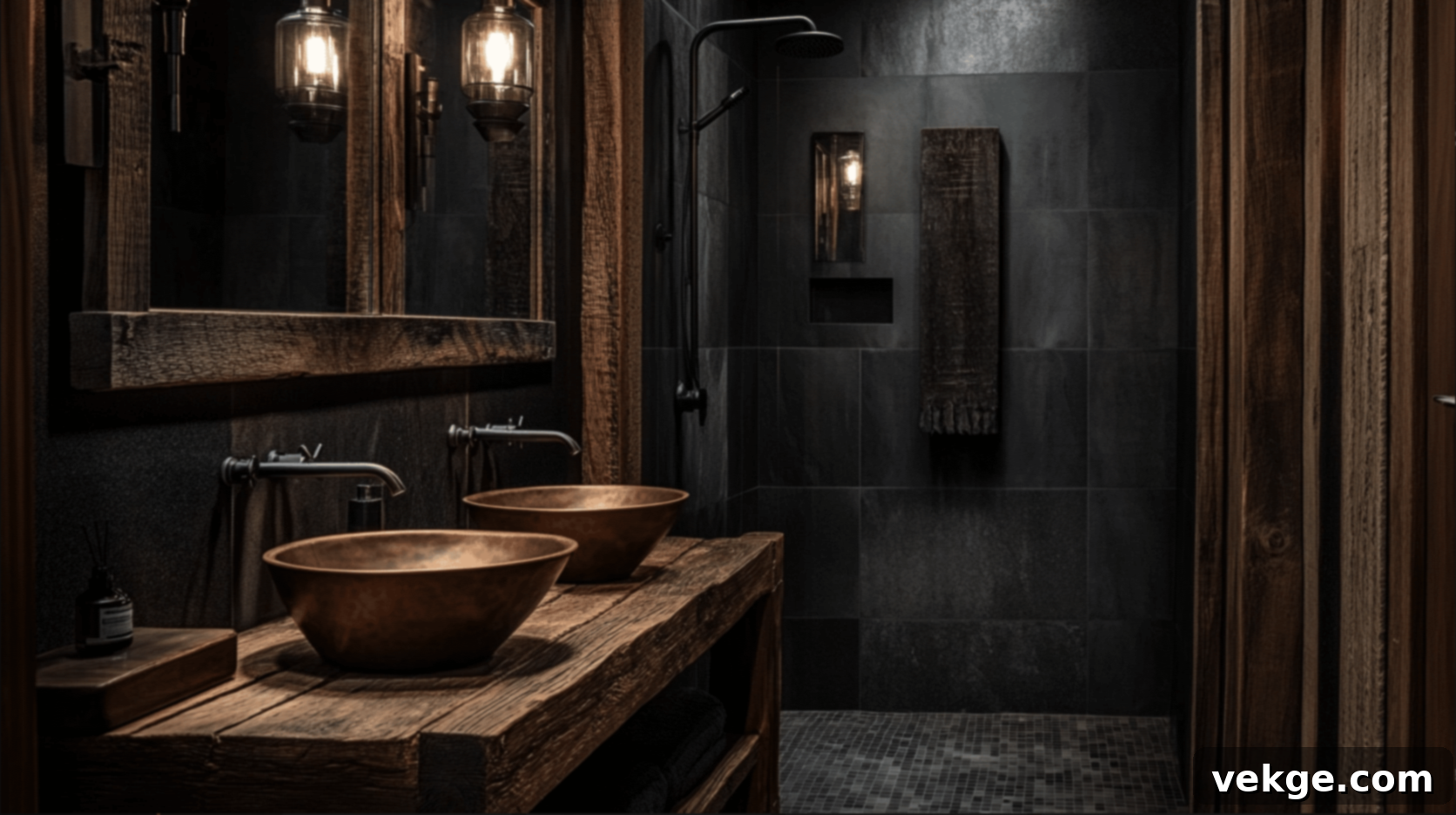
Embracing a cozy, rustic aesthetic, this design features the deep, antique appeal of oil-rubbed bronze for the main shower fixtures, immediately establishing an old-world foundation. Complementing this, stunning copper sink basins introduce an even warmer, more vibrant metallic element, creating a harmonious blend of earthy tones. To prevent the look from becoming too traditional and to introduce a contemporary edge, matte black light fixtures are strategically placed. This mix beautifully marries the warmth of classic rustic metals with the sleekness of modern accents, crafting a welcoming and character-rich space.
3. Coastal Cool: Brushed Nickel with Subtle Brass Accents
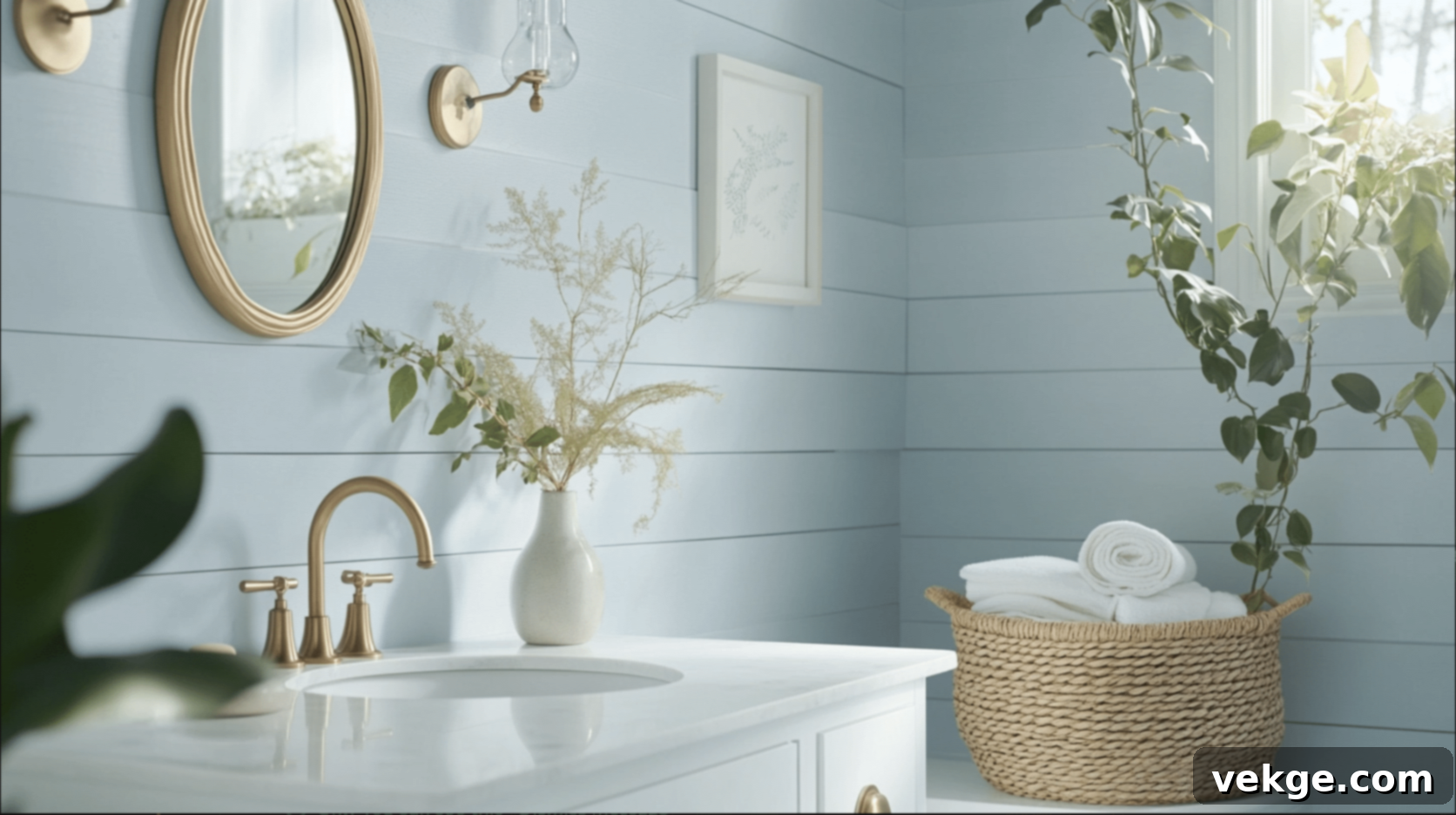
Inspired by the serene tranquility of the beach, this bathroom predominantly utilizes brushed nickel for its main fixtures (faucets, shower hardware). The soft, muted sheen of brushed nickel perfectly captures the airy, relaxed vibe of a coastal theme. To add a touch of understated warmth and prevent the cool tones from feeling stark, delicate touches of brass are incorporated through the mirror frame and subtly on cabinet pulls. This thoughtful blend creates a fresh, bright, and inviting atmosphere that embodies relaxed sophistication, where the cool base is gently warmed by metallic sunshine.
4. Glam Factor: Polished Nickel with Dazzling Gold
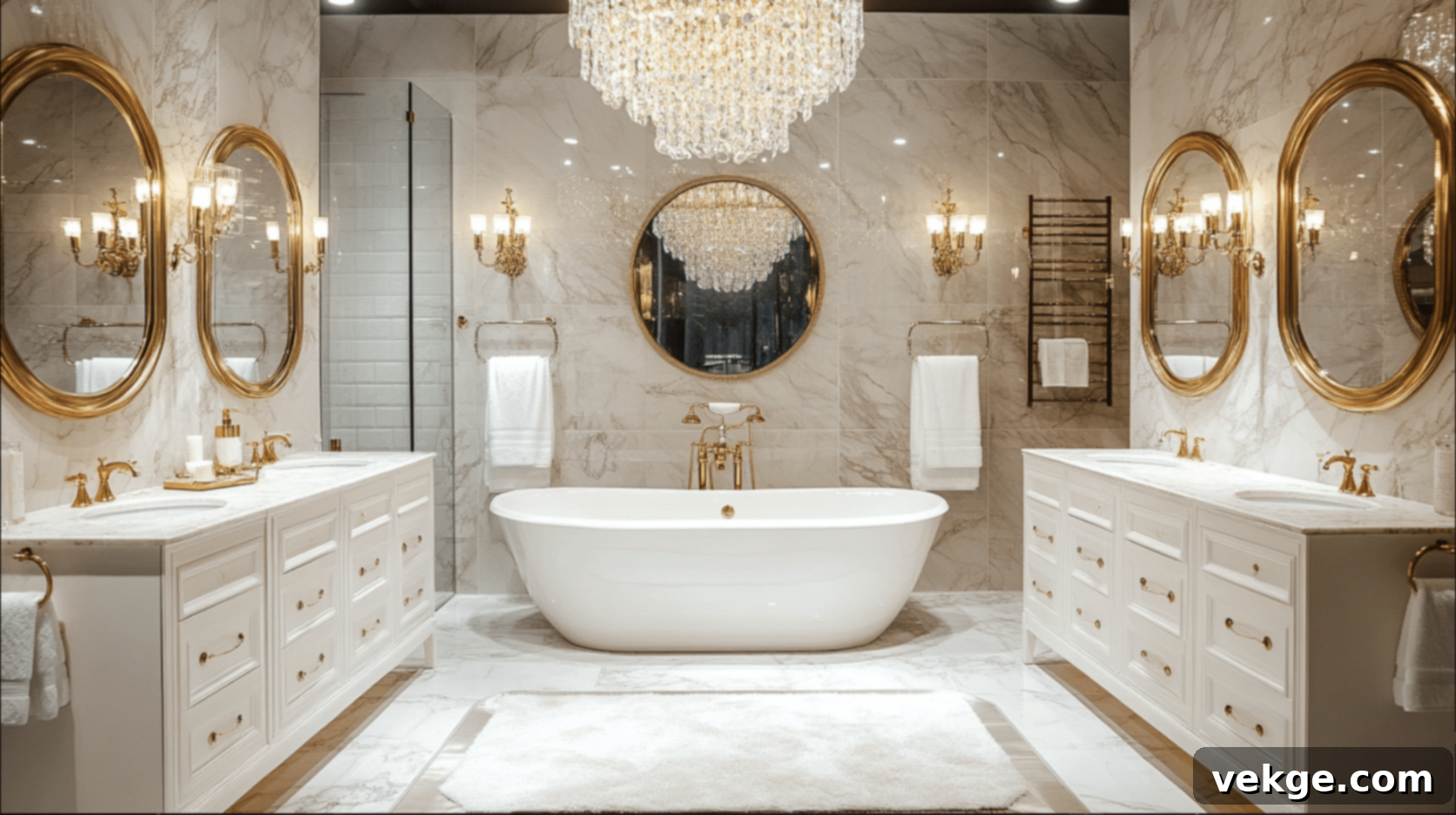
For those who crave luxury and sparkle, this glamorous bathroom design combines the refined elegance of polished nickel faucets with the opulent radiance of gold-framed mirrors and striking light fixtures. Both finishes boast a high-shine quality, ensuring they magnificently reflect light around the room. This strategic choice not only makes the space feel more expansive and brighter but also amplifies the sense of lavishness and sophistication. The blend of these two gleaming metals creates an atmosphere of pure indulgence and Hollywood regency.
5. Industrial Chic: Matte Black, Copper, and Raw Elements
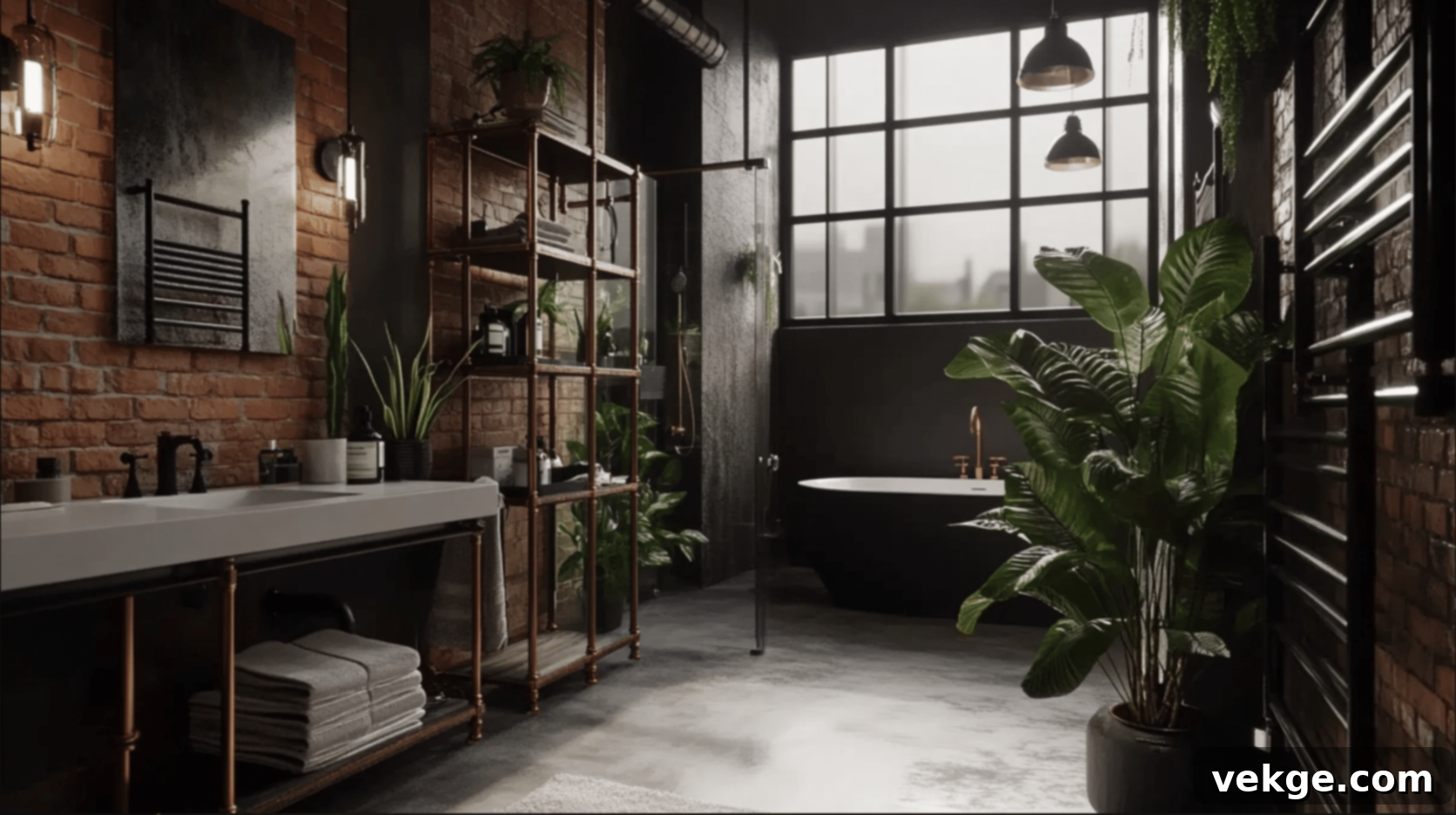
Achieving a cutting-edge industrial aesthetic, this bathroom cleverly pairs the bold, non-reflective presence of matte black for shower fixtures and cabinet handles. This dark, modern base creates a strong, foundational contrast against the unexpected warmth and texture of visible copper pipe shelving or accents. The juxtaposition between the cool, dark matte black and the bright, earthy tones of copper adds significant depth and raw visual interest. This daring mix celebrates utilitarian design with an artistic flair, proving that contrasting materials can create a surprisingly harmonious and stylish space.
Final Thoughts on Mixing Metals for a Stylish Bathroom
Embracing the trend of mixing metals in your bathroom is a phenomenal way to infuse your space with personality, sophistication, and a truly unique style. By understanding the distinct characteristics of various metal finishes and applying thoughtful design principles, you can move beyond conventional aesthetics and craft a bathroom that feels genuinely bespoke.
Remember these core tenets: select a dominant metal to anchor your design, introduce a secondary metal for strategic contrast (often balancing warm and cool tones), and sparingly use a third accent metal to add layers of depth. Ensure your chosen metals are distributed harmoniously throughout the space, and always consider how they interact with your bathroom’s overall style and existing color scheme.
Don’t shy away from experimentation; the beauty of this trend lies in its flexibility. Whether your preference leans towards the inviting warmth of brass, the crisp coolness of chrome, the modern edge of matte black, or the rustic charm of oil-rubbed bronze, there’s a perfect combination waiting to be discovered. If you’re hesitant to dive in fully, start small by mixing metallic accessories or light fixtures before committing to larger elements.
Your bathroom is a reflection of your personal style, so trust your instincts and create a space that brings you joy and comfort every day. We’d love to see your inspired mixed metal bathrooms! Share your makeover photos on social media and tag us to spread the inspiration. For more tailored guidance, consider reaching out to a local interior designer who can help bring your vision to life.
Frequently Asked Questions (FAQs) About Mixing Bathroom Metals
Is It Okay to Mix Metals in The Bathroom?
Absolutely! Mixing metals in the bathroom is not only okay but is also a highly popular and recommended interior design trend. When executed thoughtfully, it adds significant depth, visual interest, and a custom, designer-quality look to your bathroom, elevating it beyond a monochromatic scheme.
Should All Hardware in The Bathroom Match?
No, it’s generally not necessary, and often not desirable, for all hardware in the bathroom to perfectly match. While there was a time when this was the conventional approach, contemporary design embraces the sophistication of mixing metal finishes. The goal is to create a cohesive and curated design through strategic contrast and repetition, rather than strict matching.
How Do I Balance Warm and Cool Metals Effectively?
To balance warm and cool metals effectively, start by choosing a dominant metal (e.g., brushed nickel, a cool tone) for your main fixtures. Then, introduce a secondary metal that provides a clear contrast in tone (e.g., polished brass, a warm tone) for accents like cabinet pulls or lighting. The key is to distribute both finishes throughout the room to ensure a balanced and harmonious visual flow, preventing one side from feeling too warm or too cool.
Can I Mix Different Textures, Like Polished and Brushed Finishes?
Yes, mixing different textures such as polished and brushed finishes is an excellent way to add another layer of sophistication and depth to your bathroom design. A polished chrome faucet, for instance, can beautifully complement brushed nickel cabinet hardware. This contrast in sheen creates visual interest and makes your metal mix feel richer and more intentional.
What is a Good Rule of Thumb for the Number of Metals to Use?
A good rule of thumb is to limit yourself to two or three distinct metal finishes in a single bathroom. This typically involves choosing one dominant metal, one secondary contrasting metal, and possibly a third as a subtle accent. Using more than three different finishes can often lead to a cluttered, busy, and less cohesive look, detracting from the overall design.
